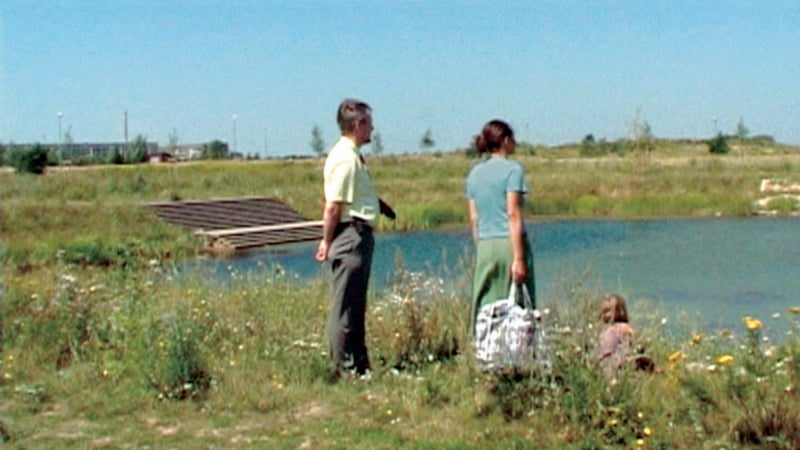
© » KADIST
Clément Rodzielski
Drawing & Print (Drawing & Print)
These photographs are installation shots of the exhibition De A à B, de B à P at Bielefelder Kunstverein (13 November 2010-30 January 2011). There, Clément Rodzielski had chosen to exhibit the series called Miroirs noirs ( Black Mirrors , black and white abstract screen prints) which is emblematic of his work. The piece of painted wood was not shown to the public; it moves and invests the space enigmatically.

© » KADIST
Clemens von Wedemeyer
Die Siedlung is a filmic documentary about the recent shift in housing developments in Leipzig-Grünau in former East Germany and its consequences on some inhabitants. It complements von Wedemeyer slightly earlier and more artistic film Silberhöhe (2003) which decried imposed Modernist living model. In Die Siedlung , a voiceover describes and criticizes the different sites on view while the camera moves slowly past a vast abandoned 1930s Nazi army barracks which has yet to be converted or demolished, the building site and wastelands for the new private single family housing area, a constructed pond and finally the 1960s or 70s communal blocks of flats.

© » KADIST
Clemens von Wedemeyer
Clemens von Wedemeyer has imagined a trip back in time at Breitenau. Starting with events that happened there from 1933 to 1945, the German artist has composed three stories that reach the years of the women’s reformatory, in the 1970s, with a different protagonist for each era. A work that attempts to bring out the “pathology” of the site, as the artist tells Bert Rebhandl, and at the same time its “unforgettable” status as a black hole in the history of Germany, that sucked up innocent lives for almost a century.

© » KADIST
Clemens von Wedemeyer
Silberhöhe , directed at Halle, located in the former GDR (German Democratic Republic), is the name of a neighborhood on the outskirts of the city, which was built in the 70’s and could accommodate more 40,000 people. The opening of the film presents us with a dramatic process that transforms the documentary image. The lack of human presence makes creates a strange atmosphere in the film.
Clemens von Wedemeyer
- location: Göttingen, Deutschland
- year born: 1974
- gender: male
- nationality: German
-
2000-2009
Clemens von Wedemeyer
2003Silberhöhe , directed at Halle, located in the former GDR (German Democratic Republic), is the name of a neighborhood on the outskirts of the city, which was built in the 70’s and could accommodate more 40,000 people...
Clemens von Wedemeyer
2004Die Siedlung is a filmic documentary about the recent shift in housing developments in Leipzig-Grünau in former East Germany and its consequences on some inhabitants...
-
2010-2019
Clément Rodzielski
Drawing & Print
2011(Drawing & Print) These photographs are installation shots of the exhibition De A à B, de B à P at Bielefelder Kunstverein (13 November 2010-30 January 2011)...
